|
|
 |
Kilns | Car Kiln | Wood Kilns | Pottery Kilns | Paperclay | Fire Trees | Constructs
Below: Nakano from the Yamanaka Clay Co. tests
the paperclay with a blow torch.
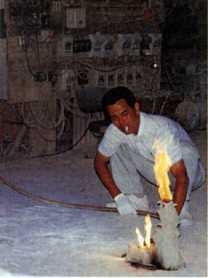
|
|
Wali Hawes builds paperclay dragons
as part of his life as a potter in Japan
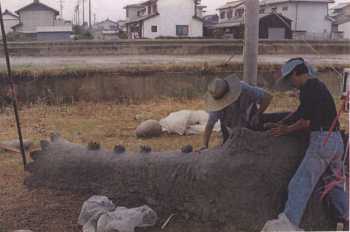
Above: The body of the dragon being constructed using the
coil method. |
Since my days as a student potter, I have always been fascinated
with kilns, especially wood fired and gas kilns. In I986 an incident
took place which sparked off what became Fired Earth Constructions
and, in particular, Fire Trees, Dragons and Fire Flowers. I spent
some time in Navapalos, in the province of Soria, Spain, learning
about adobes and rammed earth. I built a bottle kiln on site out
of adobes to fire some pottery, reaching I000'C in about eight
hours. I noticed that the kiln had fired itself (at least on the
inside) thus converting itself into a ceramic object. I later presented
these 'kilns as objects' at an art show in Barcelona and later
at several festivals and workshops in Spain and England.
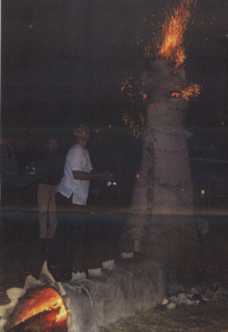
The dragon 'Yoko' at the height of the fire |
|
In I99I I moved to Japan, working as a potter and once demonstrating
my fired earth constructions to the Japanese public. I live
in Tokoname, a small town with a I000 year tradition in ceramics,
situated in central Japan, a gem among the pottery centres
of Japan. Early in I996 I heard. about a local festival in
the neighbouring town of Ono which featured the dragon as a
symbol of festivities. I had, by that time, met Kyoko Inoue,
one of the persons involved in the Festival Committee, and
I proposed to her the idea of constructing a dragon for the
festival. Finding it difficult to have my work accepted for
major art shows and festivals, I saw the Ono Dragon Festival
as a chance of proving my capabilities in this field. More
than a year later my proposal was allowed to enter the arena
of open public discussion and with a sponsor, extensive documentation
and a video of past events, they agreed to my proposal. At
last, I felt, I could do some of this work in Japan.
The building and firing was the least of my worries... until
I began to try and track down the material necessary for my
work. Normally I use adobes which are unfired sun dried clay
blocks made from a mixture of roughly sieved unrefined local
clays with a clay content as low as 40 per cent and mixed with
chopped straw. |
In England I had changed to unfired bricks as
a substitute but, in Japan, finding the type of bricks needed
for the work was difficult, and what was available was expensive.
My budget didn't allow it. It was then that I read the article 'More on
Paperclay' by Graham Hay published in CeramicsTECHNICAL No 3. I was
assured by the Ono Festival Committee that there was no shortage
of suppliers of paper pulp. After numerous phone calls, discovering
the close network between paper manufacturers, it was arranged that
I contact Daishowa Seiishi Paper Company which turned out to be in
nearby Fuji and would we kindly come and collect what we needed.
In the meantime I had been doing tests in my workshop with
newspaper, cardboard and compressed pulp but these proved fairly
unsatisfactory
due to the length of time needed to convert the material into pulp.
The compressed pulp came in sheets and needed to be broken down.
Eventually I made a soup like mixture which gave me something to
go on. Armed with this information and a van stuffed full of bags
of paper pulp, I drove to the clay company to prepare the paperclay.
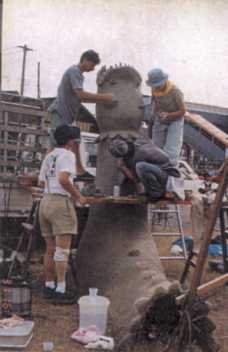
Applying the finishing touches to the paperclay dragon |
|
Convincing the boss at the clay company was another story but
he was sufficiently intrigued by the whole thing to want to try
it out. We found that breaking down the pulp into a soup like
consistency and then adding the dry clay was going to be time
consuming and we didn't have the facilities to dry out the paperclay
mixture to the consistency ready to use. So, the paper pulp in
the form it was in (lumpy and which could be picked up in handfuls)
was mixed with slightly moistened clay. If squeezed in the hand
it would form a ball but could be easily broken up. The mix proportion
was four parts paper pulp, six parts clay and one part grog.
The mixture was blended by hand and then pugged. We prepared
one ton of paperclay this way. The paperclay when ready to use
had a water content of 38 per cent.
A small model of the dragon
was made and fired with a blow torch by Nakano, the head
of the clay company. He applied an oxy acetelyne torch directly
to the
construction and took it to I300'C in about 30 seconds. To
my relief nothing untoward happened.
Finding a name for the dragon wasn't difficult. With the town's
name of Ono, no other name fitted quite so well as 'Yoko' |
A week before the festival, we started work, building
a supporting framework out of split bamboo and applying the paperclay
directly on the support. We discovered that while the bamboo structure
worked for the tail of the dragon, it was totally inadequate for
the body and we abandoned the idea during construction inclining
towards the more simple and direct coiling approach. A strong typhoon
and heavy torrential rain didn't help and because we had a deadline
to meet in order to be able to finish in time, a fire was lit inside
the body to dry out and strengthen it at the same time. In three
days we had Yoko finished and ready for firing although the clay
was far from dry; that would have required two more weeks at the
least.
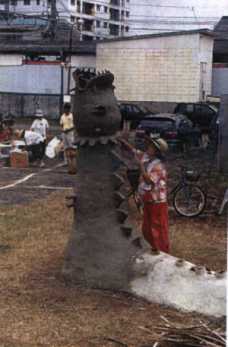
Atsuko Ito adds some further decoration to the ton weight
dragon made of paperclay |
|
We started firing around six in the morning and by about
six in the evening Yoko was behaving like a dragon coughing
up, belching out, spewing forth and bellowing smoke, sparks
and tongues of flame. Waste wood was used for the firing but
any wood with a high resin content is suitable because what
is wanted is flame rather than heat.
As the Yoko dragon was for demonstration and effect we only
fired her on the inside. On the whole, given the adverse working
environment and lack of time, the paperclay stood up well.
We pushed it to the limits Cracking was a problem but I feel
this can be solved by introducing internal supports for additional
strength and drying out the piece more thoroughly before firing.
This style of performance clay unites several aspects inherent
in the ceramic process clay, forming and fire. Fire becomes part
of the whole and is not only a tool to convert clay into ceramics.
The kiln, too, becomes a ceramic object a piece of sculpture
totally true to the elements of what it is composed.
I am now
working on a larger scale, free from the restrictions of
kiln size as well as dealing with a new concept - ceramics in the
realm of the ephemeral. |
For more information on Workshops available contact Wali Hawes :
|
 |





